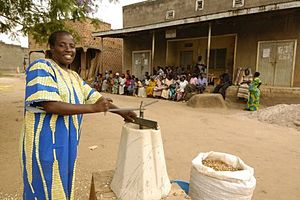- Universal Nut Sheller
-
The Universal Nut Sheller (UNS; formerly called the Malian Peanut Sheller) is a simple hand-operated machine based on a Bulgarian Peanut sheller, capable of shelling 50 kilograms (110 lb) of raw, sun-dried peanuts per hour.
It requires less than US$50 in materials to make, and is made of concrete poured into two simple fibreglass molds, some metal parts, one wrench and any piece of rock or wood that might serve as a hammer. It accepts a wide range of nut sizes without adjustment. If necessary, adjustment is quickly and easily done. It is estimated that one Universal Nut Sheller will serve the needs of a village of 2,000 people. The life expectancy of the machine is around 25 years.
The Full Belly Project is working to establish local, sustainable businesses that manufacture and distribute appropriate technologies such as the Universal Nut Sheller.
Contents
Operation
Traditional shelling in developing countries is done by hand or by some form of mortar and pestle and thus requires a lot of labor.
With the UNS, the user loads the desired crop in the space at the top. The user turns the handle, which rotates the rotor continuously. This creates centrifugal force, which pushes the nuts towards the gap at the exterior wall of the machine. There, the nuts are pulled down by gravity. As they descend, the width of the gap gradually narrows. The shell of each nut is broken at the point where the gap is sufficiently narrow and the rotor motion causes sufficient friction to crack open the shell. The tapered gap allows a range of nut sizes to be shelled. The kernels and shell fragments fall into a basket and are later separated by winnowing. The device works best for Jatropha curcas, shea, dried coffee, and peanuts (ground nuts).
The Full Belly Project has developed a Pedal Powered Agricultural Processor which is easier to use than the hand crank type, and further decreases labor in developing countries.[1] The Pedal Powered Agricultural Processor places the Universal Nut Sheller onto a pedaling chassis. In addition to the shelling method described, the pedaling apparatus is connected to a fan. The fan automatically winnows the harvest (separates the shells from the nuts). The pedal powered versions are capable of shelling the same variety of crops as the hand crank powered versions. The processor also provides access for the winnowing section to be used independently from the sheller. This allows winnowing of crops that are not shelled, such as rice, maize, sorghum etc.
Applications
The Universal Nut Sheller was originally designed to shell peanuts as a way to add value to crops for women and children. Since its inception, the Universal Nut Sheller has been found to be extremely effective at shelling other lucrative crops such as Jatropha curcas, coffee and shea.
Ghana
The Universal Nut Sheller was introduced in Ghana by Dr. Rick Brandenburg (professor of entomology) and Dr. David Jordan (specialist in crop science). These two professors from North Carolina State University had been working with a community of peanuts growers for 13 years when they heard about the Universal Nut Sheller. The yields had increased significantly during that period, and this one particular community of growers could not hand shell all of it. Local technicians were trained to build the Universal Nut Shellers.
The Universal Nut Sheller has been less than successful in Ghana. The NCState website admits the mechanism breaks 5% of the peanuts (locally called groundnuts), [2] but first hand accounts relate almost universal breakage. Users can mitigate this breakage by pouring the nuts through initially at very broad settings and only later at finer settings, this practice does not eliminate the breakage and destroys the efficiency aspect. Groundnut shelling tends to be a social activity everyone engages in during their down time and there is rarely a need for a peanut sheller.
The Universal Nut Sheller proved incapable of shelling shea nuts in a manner useful for shea butter extraction for the shea nuts of Ghana. However, there are reports that it works for shea nuts from trees in Uganda.[citation needed]
The cost also proved a significant barrier. It simply cost far more to produce (even excepting the cost of the mold, transport of materials to the village, travel to the nearest town to find someone capable of welding the metal parts, etc.) than individual growers were able to pay. However, growers unions who made the investment have been successful.[citation needed]
Awards
- 1st place - Popular Mechanics 2006 Breakthrough Awards.[3]
See also
- Full Belly Project
- Appropriate technology
- Jock Brandis
- Sanoussi Diakité
References
- ^ "Pedal Powered Agricultural Processor". Fullbellyproject.org. http://www.fullbellyproject.org/gallery.php?id=10. Retrieved 2009-06-08.[dead link]
- ^ http://www.cals.ncsu.edu/agcomm/magazine/winter10/efficiency.html
- ^ Unknown, Unknown (December 2006), "Behind the Breakthroughs", Popular Mechanics 183 (12): 18, ISSN 0032-4558
External links
- Video of Universal Nut Sheller in Uganda
- Full Belly Project - non-profit organization which designs and distributes appropriate technology, including the Universal Nut Sheller
- Peanuts-a documentary film about Brandis' creation of the first Universal Nut Sheller then known as the Malian Peanut Sheller
- Universal Nut Sheller used to dehusk Jatropha Nuts (2008) Video about Mali Biocarburant's use of the UNS to promote Jatropha curcas cultivation to generate income for poor farmers in Mali (West Africa).
Categories:- Appropriate technology
- Sustainable agriculture
- Jatropha
- Peanuts
- Coffee production
Wikimedia Foundation. 2010.


